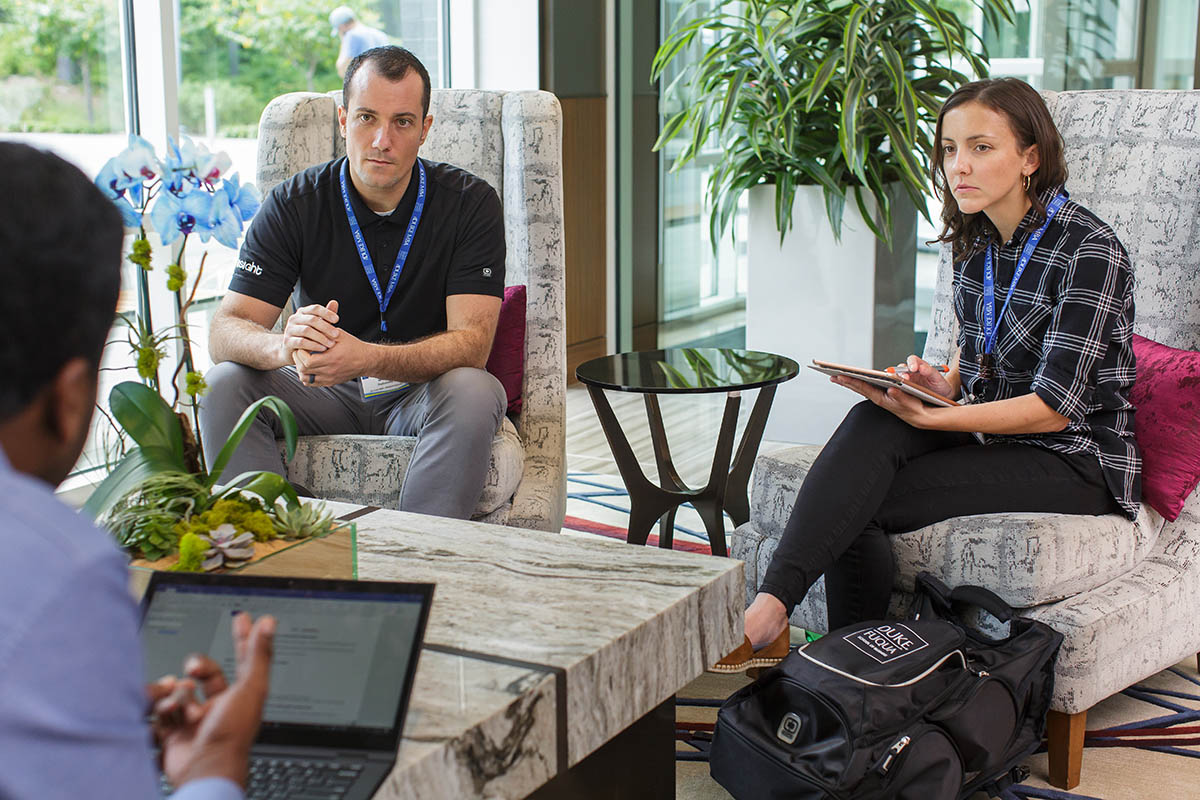Duke Global Executive MBA Student Blog

Making the Most of MBA Team Meetings
Meetings are absolutely vital to connecting with your Duke MBA team and tackling projects and assignments. However, the tendency is to overuse meetings and create them when they're not necessary. The guidelines below will help you have effective team meetings and keep everyone concretely on-task and driving towards their MBA goals.

Meetings are absolutely vital to connecting with your Duke MBA team and tackling projects and assignments. However, the tendency is to overuse meetings and create them when they’re not necessary. The guidelines below will help you have effective team meetings and keep everyone concretely on-task and driving towards their MBA goals.
Define the Intent of the Meeting
First, define and be transparent about what you want your meeting to accomplish. Below are the types of meetings we should be clear about holding:
- Making a Decision: During this meeting, you’re expecting to align a group of people on a key decision. Make sure you invite the people that are going to be directly or indirectly impacted by the decision. Be clear about the decision the group needs to agree on. A great decision-making meeting presents all information objectively, gives airtime to dissenting opinions, involves all people directly affected by the decision, and ultimately leads to a concrete decision being made.
- Sharing Knowledge: During this meeting, you’re expecting the attendees to share knowledge and direct feedback. These meetings require the organizer to prepare to deliver a clear and concise message. A great knowledge-sharing meeting leaves all participants feeling like they learned something novel, it shares the message memorably, and keeps the audience’s attention.
- Brainstorming Solutions: During this meeting, the organizer presents a clear problem the group is trying to solve and sets up the framework by which it can tackle the problem. The meeting attendees need time to prepare and think independently about the problem. The meeting organizer should provide preparation materials well in advance of the meeting—typically, a full week. A great brainstorming meeting produces many diverse ideas on how to tackle a problem, considers the ideas of everyone in the room, and ends with a clear understanding of next steps and who owns each.
- Provide Feedback: During this meeting, the organizer is expecting to provide attendees with information and receive feedback on the content. The organizer provides some leading questions to help stimulate the discussion. A great feedback meeting honestly reflects the reality of the content, gets everyone on the same page about the topic, and ends with a clear understanding of next steps and who owns each.
Set a Clear and Simple Agenda
All great meetings have a clear agenda of what you’re trying to accomplish. Make sure to communicate all materials that people need to review before the meeting. If you’re asking your attendees to prepare for the meeting, be clear about what you expect them to prepare and if there are any deliverables related to that. Write out the type of meeting you want to have and be clear on your desired outcomes for it.
Here is an example of a bad meeting agenda:
Hey—I wanted to get all of us together to discuss a few pressing topics.
Here is an example of a great meeting agenda:
Hey—I wanted to get us together to make a decision on the following topic: Should we deploy Chromebooks across our company?
Please see attached some reading materials on Chromebooks, and some pro/con checklists developed by the working team. Also, this YouTube video clearly summarizes other organizations that did something similar. This cost analysis shows us the potential savings of taking on this effort.
Please come to this meeting prepared with an opinion on this subject after you reviewed all of the materials.
Be Mindful of Who Should Attend
All of your attendees need to play a role in the meeting. Invite only people who are directly involved and have clear intent for their participation. Do not invite people that should only be peripherally involved. Time is precious, so don’t make people feel obligated to join meetings that are not useful for them.
Additionally, be cognizant of the timezone of the attendees. Do not make people attend meetings at 10 p.m. their time if it’s not an emergency.
Be Mindful of Remote Participants
Remote participation in meetings is an increasing reality of our world. Here is a general rule: If one person is remote, then everyone is remote. We must respect the feedback and input of everyone that attends. Do not segment people to participate in meetings where they have to fight for attention with people located in a physical conference room. Level the playing field, and respect the feedback of everyone in the meeting regardless of their location.
Document Decisions and Follow-Up Actions
When the meeting is done, it is the burden of the organizer to summarize the meeting and outline clear next steps along with naming the responsible parties for each. If a decision was made, clearly document it and inform everyone that needs to be aware.
If you booked the meeting, it’s your responsibility to ensure that everyone stays on the same page even after the meeting ends. You’re the meeting captain, so you take ownership.
Synchronous vs. Asynchronous
Determine if you even need a meeting in the first place. According to the Harvard Business Review, 71% of employees feel that their meetings are largely unproductive and inefficient.
Before booking one, ask yourself, “Do I really need this meeting? Is there a way to accomplish the same result without it?” If the answer to the second question is yes, be respectful of your colleagues’ time and define a framework to accomplish the goal asynchronously.
Working asynchronously respects the working hours of everyone and allows people to work on their own time. Don’t force a synchronous meeting unless it’s absolutely necessary or if it adds value to the work.
Here are some ways to be more asynchronous and achieve similar results:
- Record a video of yourself explaining a topic and requesting feedback. Allow people to watch the video and log responses. Videos should not exceed 10 minutes.
- Write a document that clearly outlines the problem and a clear call-to-action for each participant. Share this feedback widely with all people who are part of the process.
- Create a visual workflow chart that outlines a particularly difficult concept.
The Global Executive MBA program is a whirlwind of activity, so using these guidelines to make the most of your team meetings will help set you on the right path to optimizing the learning experience.



